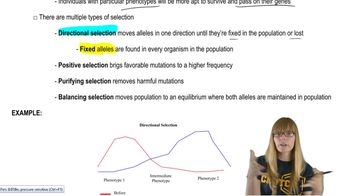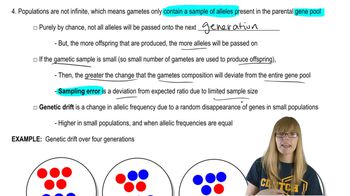Table of contents
- 1. Introduction to Genetics51m
- 2. Mendel's Laws of Inheritance3h 37m
- 3. Extensions to Mendelian Inheritance2h 41m
- 4. Genetic Mapping and Linkage2h 28m
- 5. Genetics of Bacteria and Viruses1h 21m
- 6. Chromosomal Variation1h 48m
- 7. DNA and Chromosome Structure56m
- 8. DNA Replication1h 10m
- 9. Mitosis and Meiosis1h 34m
- 10. Transcription1h 0m
- 11. Translation58m
- 12. Gene Regulation in Prokaryotes1h 19m
- 13. Gene Regulation in Eukaryotes44m
- 14. Genetic Control of Development44m
- 15. Genomes and Genomics1h 50m
- 16. Transposable Elements47m
- 17. Mutation, Repair, and Recombination1h 6m
- 18. Molecular Genetic Tools19m
- 19. Cancer Genetics29m
- 20. Quantitative Genetics1h 26m
- 21. Population Genetics50m
- 22. Evolutionary Genetics29m
21. Population Genetics
Allelic Frequency Changes
Problem 18
Textbook Question
What are considered significant factors in maintaining the surprisingly high levels of genetic variation in natural populations?
 Verified step by step guidance
Verified step by step guidance1
Consider the role of mutation: Mutations introduce new genetic variations into a population by altering DNA sequences. These changes can be beneficial, neutral, or deleterious, and they contribute to the genetic diversity within a population.
Examine the impact of gene flow: Gene flow, or the movement of genes between populations, can introduce new alleles into a population, increasing genetic variation. This occurs when individuals from different populations interbreed.
Analyze the effects of natural selection: Natural selection can maintain genetic variation by favoring different alleles in different environments or by balancing selection, where multiple alleles are maintained in a population due to selective advantages.
Consider genetic drift: Genetic drift is the random fluctuation of allele frequencies in a population. In small populations, genetic drift can lead to significant changes in allele frequencies, contributing to genetic variation.
Explore the role of sexual reproduction: Sexual reproduction increases genetic variation by combining alleles from two parents to produce offspring with unique genetic combinations. This recombination of alleles during meiosis and fertilization contributes to the genetic diversity of a population.
Recommended similar problem, with video answer:
 Verified Solution
Verified SolutionThis video solution was recommended by our tutors as helpful for the problem above
Video duration:
2mPlay a video:
Was this helpful?
Key Concepts
Here are the essential concepts you must grasp in order to answer the question correctly.
Genetic Variation
Genetic variation refers to the differences in DNA sequences among individuals within a population. This variation is crucial for evolution and adaptation, as it provides the raw material for natural selection to act upon. High levels of genetic variation can enhance a population's ability to survive environmental changes and resist diseases.
Recommended video:
Guided course

Genomic Variation
Natural Selection
Natural selection is a process where individuals with advantageous traits are more likely to survive and reproduce, passing those traits to the next generation. This mechanism can influence genetic variation by favoring certain alleles over others, but it can also maintain variation if different traits confer advantages in varying environments, leading to a balance of traits within a population.
Recommended video:
Guided course

Natural Selection
Gene Flow
Gene flow, or gene migration, is the transfer of genetic material between populations through processes such as migration and interbreeding. This exchange can introduce new alleles into a population, increasing genetic diversity and counteracting the effects of genetic drift, which can reduce variation. Gene flow is essential for maintaining genetic variation, especially in fragmented habitats.
Recommended video:
Guided course

Mapping Genes

 5:58m
5:58mWatch next
Master Natural Selection with a bite sized video explanation from Kylia Goodner
Start learning



